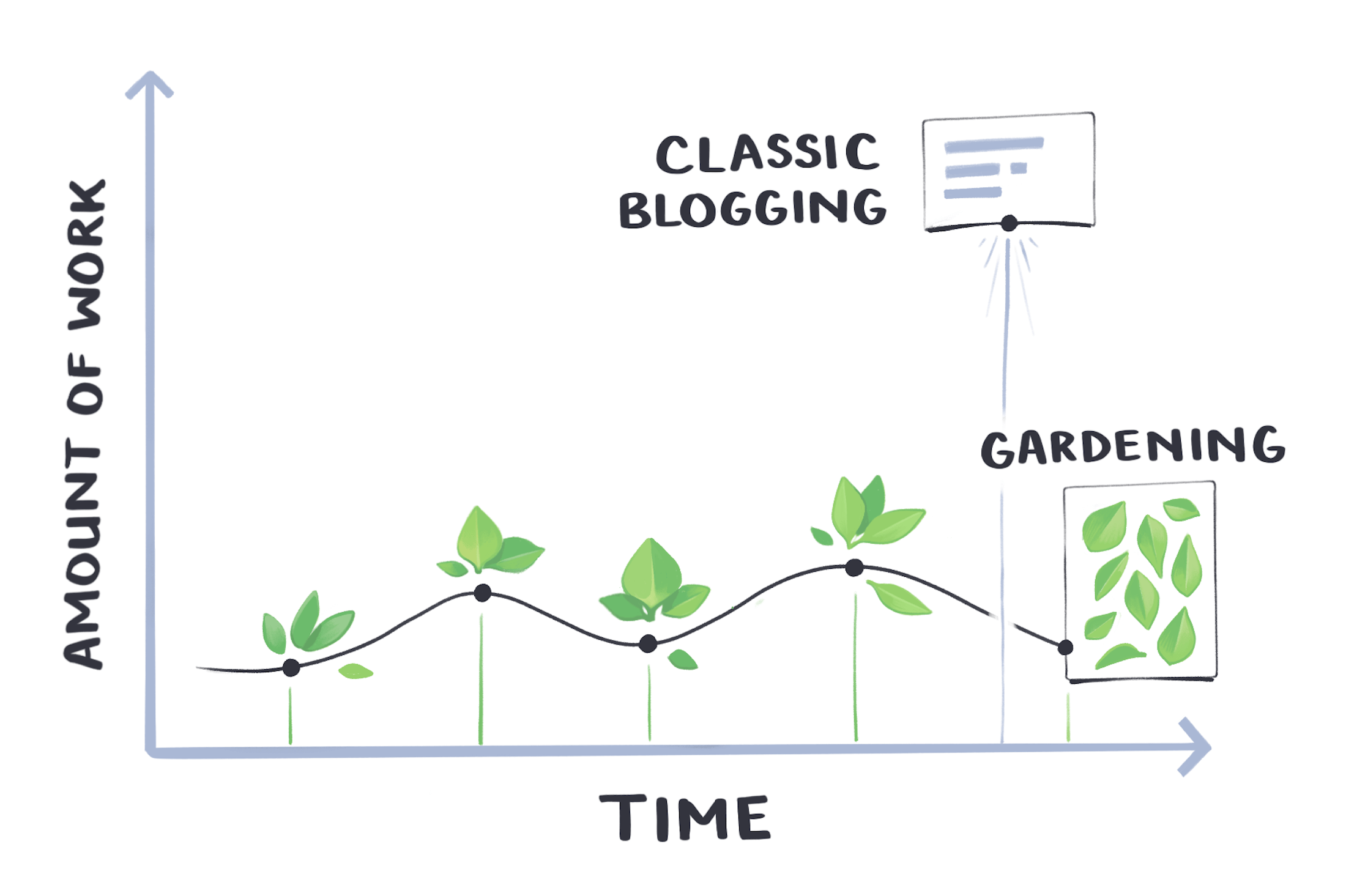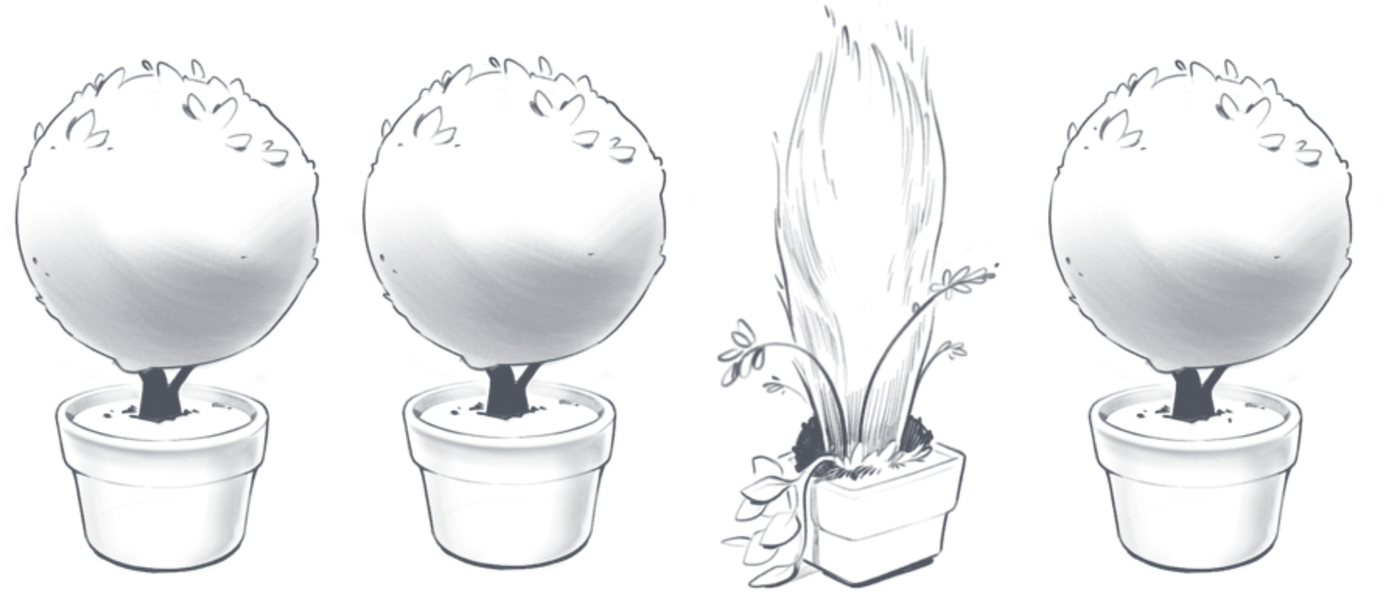On Digital Gardening
# Notes
From my Are.na channels: Digital Gardens and Tools for Thought
# How the Blog Broke the Web
- Homepages
- Built by hand
- no two were alike
- Dominant metaphor: table of contents > diary entry
- We all became amateur librarians
- Early web restrictions
- Online
- HTML knowledge
- Hosting account
- Slow shift to rapid web publishing; instead of building their own systems, users were working inside one; from manual to effortless
- Chronlogical Sort era/reverse chronology bias -> death of the old, cool, weird and hand-organized web
# Of Digital Streams, Campfires and Gardens
- How do we build and maintain our own personal information gardens? Not streams - but environments we can tend and grow over decades
- The garden and the stream, a technopastoral
# The garden and the stream, a technopastoral
the predominant form of the social web — that amalgam of blogging, Twitter, Facebook, forums, Reddit, Instagram — is an ==impoverished model for learning and research== and that our survival as a species depends on us getting past the sweet, salty fat of ==“the web as conversation”== and on to something more timeless, integrative, iterative, something less personal and less self-assertive, something more solitary yet more connected.
Two approaches to the Web: the Garden and the Stream
# The Garden
- old metaphor associated with hypertext
- The Garden of Forking Paths
- Wiki Gardener
- Hypertext Gardens
- The Garden is the web as topology.
- Topology in networking: layout of a computer network
- The web as space. It’s the integrative web, the iterative web, the web as an arrangement and rearrangement of things to one another.
- ^ this is because things here don’t collapse to a single set of relations/canonical sequence (see bi-directional links)
- Every walk through the garden creates new paths, new meanings, and when we add things to the garden we add them in a way that allows many future, unpredicted relationships
The bridge is a bridge is a bridge — a defined thing with given boundaries and a stated purpose. But the multi-linear nature of the garden means that there is no one right view of the bridge, no one correct approach. ==The architect creates the bridge, but it is the visitors to the park which create the bridge’s meaning.== A good bridge supports many approaches, many views, many seasons, maybe many uses, and the meaning of that bridge will even evolve for the architect over time.
- The bridge and garden are related to one another inan timeless way
- Same goes for everything in the garden in relation to the gardener
- We create the garden as a sort of experience generator, capable of infinite expression and meaning.
# The Stream
- newer metaphor, old roots
- programming “event stream”
- “lifestream” proposed by researchers in the 1990s
- stream -> neverending parade of Twitter, news alerts, Facebook feeds
- In the stream metaphor you don’t experience the Stream by walking around it and looking at it, or following it to its end. You jump in and let it flow past. You feel the force of it hit you as things float by.
- You can be active in the stream, but your actions exist in a context that is collapsed down to a simple timeline of events that together form a narrative.
- The Stream replaces topology with serialization
- Timeless world of connection and multiple paths -> sinfle, time ordered path with our experience at the center
- best seen through the lens of Bakhtin’s idea of the utterance.
- Bakhtin saw the utterance, the conversational turn of speech, as inextricably tied to context.
- To understand a statement you must go back to things before, you must find out what it was replying to, you must know the person who wrote it and their speech context.
- To understand your statement I must reconstruct your entire stream.
# Implications
- Lack of Open Educational Resources
- Everybody wants to play in the Stream, but no one wants to build the Garden.
- What is harder to understand is how in nearly 25 years of the web, when people have told us what they THINK about local subsidies approximately one kajillion times we can’t find one — ONE! — syllabus-ready treatment of the issue.
- Mostly scattered resources
- Everybody wants to play in the Stream, but no one wants to build the Garden.
- Learning Design
- David Cormier: “every we makes a them”
- You get a large class together and it fragments, partially to protect itself from scale. Cliques develop. The cool kids table emerges. Others complain they are not being attended to, the cool kids say well sorry but we know each other and we want to sit next to one another.
- We and them is built into the logic of the Stream.
- We assume online interaction is about conversation via blogging, tweeting, commenting
- Kate Bowles: had a metaphor she liked for the learning environment of what we are calling gardeners here
- She talked about Studio Space, the idea of working next to people while building, of looking at their stuff out of the corner of your eye. Your work reacts and connects to theirs, not in this disposable or reactive way, but in this iterative way.
- David Cormier: “every we makes a them”
# Maggie Appleton on Digital Gardening
https://maggieappleton.com/evergreens
https://maggieappleton.com/garden-history
It harkens back to the early days of the web when people had fewer notions of how websites “should be.” It’s an ethos that is both classically old and newly imagined.
It captures the desire for exploratory experiences, a welcoming of digital weirdness, and a healthy amount of resistance to top-down structures.
# The Six Patterns of Gardening
- Topography over Timelines
- organized contextual relationships and associative links
- best way to do this through bi-directional links
- many entry points, no prescribed pathways
- gardeners often layer on other ways of exploring their knowledge base
- thematic piles
- nested folders
- tags and filtering functionality
- advanced search bars
- visual node graphs
- central indexes
- gardeners often layer on other ways of exploring their knowledge base
- Continuous Growth
- constantly growing, evolving, changing
- evolves alongside your thoughts
- fuzzy and unrefined -> developed idea
- the process of researching and refining happens on the open internet
- Imperfection & Learning in Public
- imperfect by design
- Domestic Cozy
- intimate and public; less peformative, more intentional and thoughtful
- perfect balance of chaos and cultivation
- Imperfection -> learning in public
- See Digital Garden Terms of Service
- Playful, Personal, and Experimental
- non-homogenous by nature
- same seeds, different arrangements
- organised to match your way of thinking
- One goal: deep contextualisation
- response to Cards/context collapse
- non-homogenous by nature
- Intercropping & Content Diversity
- not just a collection of interlinked words
- audio-visual cornucopia
- allows for more than just words
- Historically, monocropping has been the quickest route to starvation, pests and famine…sustainably intercrop instead
- Independent Ownership
- small patch of the web that you own and fully control
- not on social media platforms
- helps you plan long-term change
- prepare for a future of digital gardening that’s hopefully multi-player






https://github.com/MaggieAppleton/digital-gardeners
I want to add a final note on here: we should be careful not to mistake the technical features of a garden for the ethos of gardening. We have reached the point in the gardening hype train where people seem to think backlinks, hover previews, and visual graphs are what define a “digital garden.” This is misguided. ==Gardening is a practice that treats a personal website as a constantly evolving landscape where you develop your ideas in public.== Gardens are… a) Explorable, rather than structured as a strictly linear steam of posts. This is usually achieved through deeply interlinking notes where readers can navigate freely through the content. b) Slowly grown over time, rather than creating “finished” work that you never touch again. You revise, update, and change your ideas as they develop, and ideally find a way to indicate the “done-ness” state to your reader.
# Miscellaenous

# Outline
- Web 1.0
- Social media v.s. Personal website; garden v.s. Stream
- How to digital garden?
See Canva presentation here